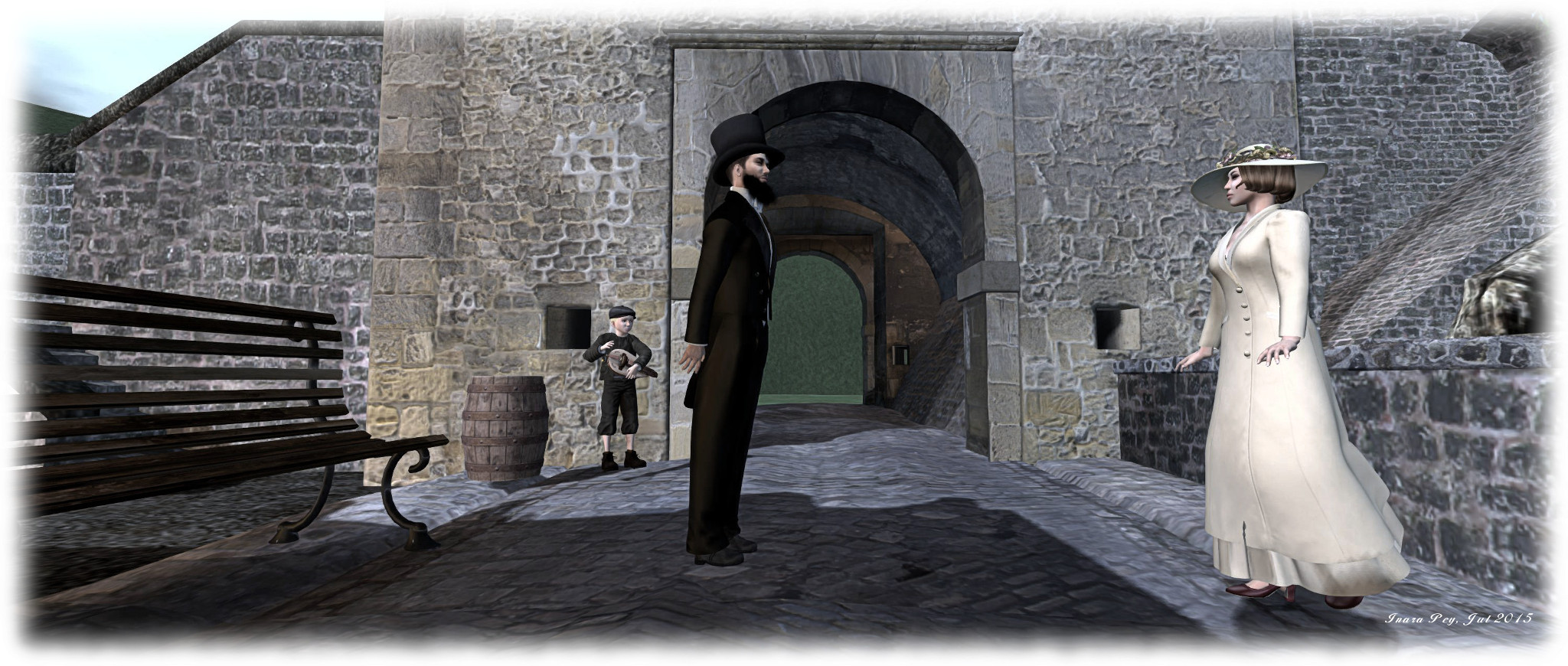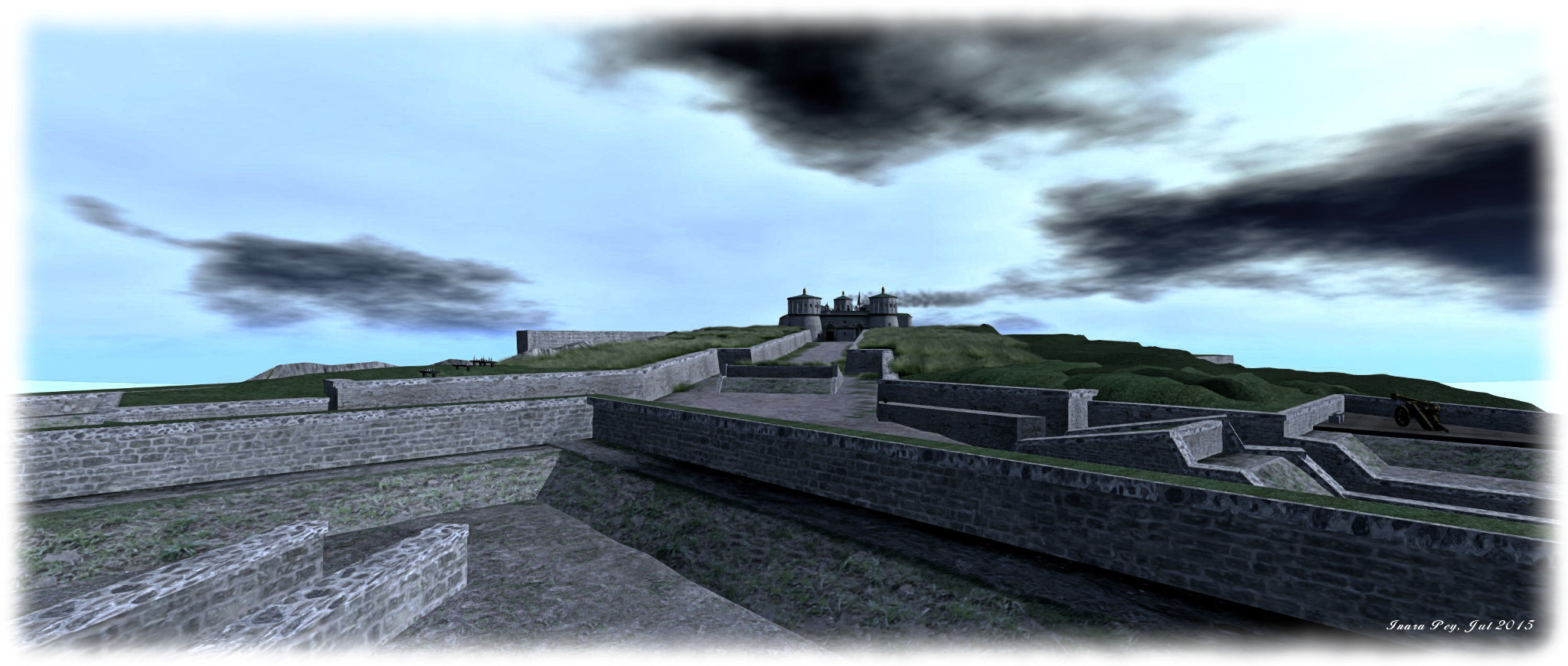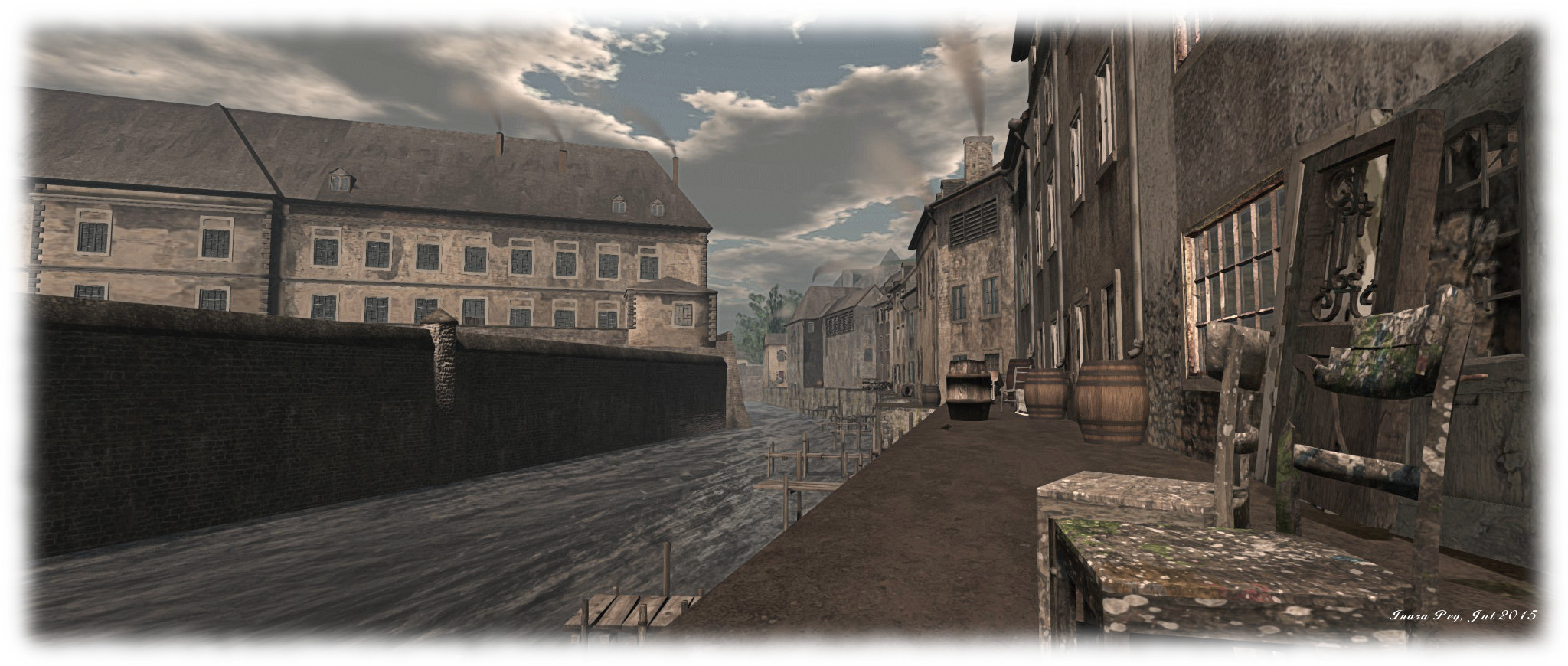 The Virtual Pfaffenthal, July 2015 (Flickr) – click any image for full size
The Virtual Pfaffenthal, July 2015 (Flickr) – click any image for full size
Currently featured in the Editor’s Picks section of the Destination Guide, The Virtual Pfaffenthal is interesting mix of role-play environment and historical project which crosses over into the real world.
The project – run by the 1867 group founded by Hauptmann Weydert (Weydert), comprises 8 regions, with Pfaffenthal Vauban and Kirchberg being the most developed, although there is much evidence of construction work going on in the other regions. Kirchberg is actually the home of Fort Thüngen, which has been in operation in SL since 2012, and as such may be familiar to some SL residents.
 The Virtual Pfaffenthal, July 2015 (Flickr)
The Virtual Pfaffenthal, July 2015 (Flickr)
Eventually, the regions will offer a reproduction of the fortress city of Luxembourg as it appeared in the 19th Century, offering a period role-play focused on a specific point in the city’s history, as the introductory note card explains:
In spring 1867, Luxembourg is a complex military fortress, the ultimate result of a construction that took hundreds of years, a city occupied by a Prussian garrison. The Grand Duchy is an ‘autonomous’ country and member of the Zollverein, the customs union established by Prussia. The attempt of Napoleon III to buy the land from the Grand Duke King William the first, creates tensions among the population, trouble spreads throughout the capital and the country. The great nations send their secret agents and mobilize their troops, Bismarck intervenes …
However, there is another purpose to the project, as I alluded to in the opening paragraph of this article: it forms an interactive exhibit at the Luxembourg City History Museum, where visitors can come in-world and explore the virtual Luxembourg of 1867 using the Oculus Rift.
At the museum, PCs have been set-up which can be used, with guidance from staff, to directly access The Virtual Pfaffenthal. “We have two PCs set-up right now,” Weydert informed me when we met in-world to discuss the project as he prepared to host a group of visitors at the museum. “One has an Oculus HMD, the other uses a big screen. A further Oculus Rift set up is to follow shortly.”
Visitors use prepared avatars, complete with period dress, to explore the city, guided by a young boy, Steft who tells them the history of the City from both his perspective and that of 1867.
 Visitors at the City History Museum, Luxembourg, can enter The Virtual Pfaffenthal using prepared avatars such as Jang and Ammy Ecker, above, enjoying a dance on the street, to music by Steft, the virtual guide, in the background
Visitors at the City History Museum, Luxembourg, can enter The Virtual Pfaffenthal using prepared avatars such as Jang and Ammy Ecker, above, enjoying a dance on the street, to music by Steft, the virtual guide, in the background
“This has actually be quite a challenge,” Weydert confides in me as we chatted and strolled along the cobbled streets. “We didn’t want people finding themselves accidentally undressing the avatars or teleporting themselves off somewhere, so we’ve had to turn off a number of functions in the viewer.”
Not only are visitors able to time-travel in this way, and witness how Second Life can be used as an immersive experience, Weydert also offers museum visitors the museum the opportunity to learn more about Second Life itself. “I run open workshops on certain days,” he explains, “where folks can learn to create their own avatar, find out more about SL, and then continue their explorations and involvement from home. We also encourage School classes to register for the workshops, so they can learn more about Luxembourg’s history interactively.”
This aspect of the project is something of an extension of activities started at Fort Thüngen. For the last few years, this has been the focal point for workshops on virtual environments involving the general public and schools, with sessions hosted at the Fortress Museum in Luxembourg in association with the Luxembourg National Museum of History and Art.
 Fort Thüngen, Kirchberg, has been in operation since 2012 as a workshop for virtual activities since 2012, and is now a part of the wider regions making up the 1867 project
Fort Thüngen, Kirchberg, has been in operation since 2012 as a workshop for virtual activities since 2012, and is now a part of the wider regions making up the 1867 project
The educational element of the project is of keen interest to the team, which they’d like to expand. “We want to include schools and other institutions,” Weydert told me, after a slight distraction as he assisted a visitor at the museum. “Such as classes having avatars their students can use to participate [in-world] the whole term.”
So far, the 1867 group has been run on a closed basis, but with the museum element now running, Weydert and his team are keen to open out the venture to include other residents, and grow it as an ongoing venture in Second Life.
“1867 invites residents, artists, 3D builders and graphic artists, scripters, animators, educators and other social actors to come and join us,” he says. “We want to build a community where people can come, enjoy themselves, and in the process learn from history and contribute to our growth.”
 The Virtual Pfaffenthal, July 2015 (Flickr)
The Virtual Pfaffenthal, July 2015 (Flickr)
Those that do engage with the community are offered free housing within the project – although they are obviously asked to keep to the period. Those interested are invited to explore the regions and contact Hauptmann Weydert if they’d like to become a part of the group.
Beyond this, the 1867 group are also considering some pretty far-reaching plans, such as a series filmed entirely in-world within the project spaces together with a supporting comic book, in what Weydert refers to as a transmedia project aimed at engaging students and those interested in history and in discovering more about virtual worlds.
 The Virtual Pfaffenthal, July 2015 (Flickr)
The Virtual Pfaffenthal, July 2015 (Flickr)
For my part, I spent a pleasant afternoon wandering the streets of Pfaffenthal, feeling at home in a free period costume provided to visitors from SL, and encountering a number of the residents along the way. It would be intriguing and interesting to experience The Virtual Pfaffenthal via a HMD, but I’ll content myself with future visits to see how things progress.
My only real disappointment in visiting was seeing the number of people who simply could not be bothered to read – or disregarded – the request that they wear period costumes prior to leaving the arrival area. Considering perfectly good free outfits are clearly and readily available (you have to walk past them to reach the doors), this struck me as a shame.
SLurl and Additional Links
- The Virtual Pfaffenthal (Rated: General)
- Fort Thüngen (Rated: General)
- 1867 Group on Facebook
- Additional information downloads (Dropbox)
- The Virtual Pfaffenthal at the City History Museum, Luxembourg (French)
It is probably not a surprise that I think that Time travel is the BEST function of Virtual Reality 🙂
This project is a great example, very well done.
And yes, it is always a shame that there are people who don’t bother following the rules, after 6 years of 1920s Berlin, we still have to deal with that now and then.
LikeLike
I agree about the outfits and to think that it does worth to visit the sim even just for the free costume; well, maybe not, but that gown is pretty! 🙂 I enjoyed to ride the horses too and the place looks great and with a potential
LikeLike
Reblogged this on Windlight Magazine and commented:
Inara covers the new Luxembourg 1867 Project:
LikeLike
Thank you so much Jphn for reblogging!
LikeLike
Thank you for this wonderful article, really enjoyed the interview as well!
LikeLike
Thank you for taking the time to chat with me, considering you were preparing for a tour! The time was very much appreciated! Look forward to visiting in-world again 🙂 .
LikeLike
Definitely going to check this out!
Congratulations to Hauptmann Weydert and his team for tackling such an interesting project.
Thanks to Inara for bringing it to our attention.
Shared on “Historical Communities & Royal Courts” at:
http://royalcourts.ning.com/forum/topics/inara-pey-covers-love-henry-luxembourg-1867#.VbzFb_lVhBc
LikeLike